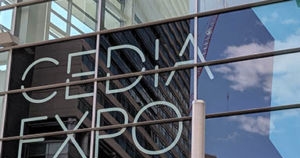You may have missed it but the CEDIA 2019 show took place earlier this month, bringing together thousands of home technology professionals and hundreds of exhibitors for a weeklong expo. For those unable to make the trip out to Denver for this year’s show, I’d like to share a few of my takeaways from what proved to be a thought-provoking experience.
Across the Board Display Improvements
As expected, the expo served an important purpose by showcasing incremental but substantive improvements in the displays solutions we all have enjoyed in the past. Displays of every effective technology were demonstrated for the discerning professionals in attendance. Among the more interesting items on display were 98” LCD panels exhibiting spectacular 4K and 8K image performance. These are worth keeping an eye on (apologies for the turn of phrase). Elsewhere on the floor DLP technology ranging from the lowest entry to the highest-end products certainly showed strong improvement. The hybrid SXRD technology looked promising as well.
Beyond these technological enhancements what I really came away with was the impression that an important pivot point was approaching for the in-home display market in particular. Perhaps this inflection point has already arrived but in any case, I sense a new, potentially billion dollar market will soon emerge and accelerate rapidly.
In-Home Cinema is Pivoting
The true professional in-home cinema market was born with the introduction of projection CRT in the 1980s, evolved with a DLP pivot in the late 1990s and rounded into form with the large screen LCD revolution in 2000’s. Each of these developments have helped to grow the in-home display market in to a multi-billion dollar giant. The next pivot will only further the in-home experience in its usurpation of the out-of-home market and I believe this year’s CEDIA show indicated that pivot will be in the direction of emissive LED. Let me explain my thinking here by commenting first on the state of the out-of-home market because in many ways developments on that front portend similar ones in-home.
Out-of-Home Trends Influence In-Home Trends
It’s not hard to notice that out-of-home theater revenue growth is anemic. Trends for this market are perplexing. Based upon recent surveys, roughly 50% of the population in the US almost never or never go to an out-of-home movie! About 30% of US viewers go see a movie only a few times a year. In other words, most people aren’t escaping to the movies anymore. While the studio may be offsetting declining revenue in first run movies with expanded distribution in the channel, a focus on growth must be established. Romantically, the cinema experience is all about “a story well told,” and while new capture tools, processing, CGI, storage, editing, and production processes have advanced dramatically in the past two decades, the technical display solutions for showcasing cinema content have taken a back seat. The current solutions are fine but fine isn’t pulling anyone off the couch anymore.
A Story Well Told Requires Better Displays
Matching the dramatic improvement in the technologies storytellers use to create and dress their stories will require a display solution more capable than current options while still possessing a path to continuous improvement. That’s got to be LED. For one thing, LED hits darker darks, including blacks below human perception and a first grayscale step 1/100th that of most projectors. Its brights are brighter, too; past theater brightness levels of 48 nits (14ftL) can be bested by recent systems that have demonstrated levels of up to 140ftL.
This expanded range is more comprehensive between the extremes, too. A bit depth of 12 bits gives storytellers the power to replicate colors exactly and bit allocation to extreme specular highlights lets them better approximate images of reflections and the sun. There’s also no need for color filters.
I’ve written with a focus on LED’s potential to improve the out-of-home cinema experience in the past (hyperlink to that older post) but I believe it can find similar success in the in-home theater market as well. LED doesn’t yet have the foothold in-home that LCD and projection do but that’s kind of the point; without much of a real focus on the in-home market, LED is already superior in a range of metrics. Imagine how much better it will get once it is optimized for these environments.
LED is Next in Line
CEDIA showed me we’re at the threshold of a new place in time for visual entertainment, especially within the in-home theater segment. If the out-of-home market is any indication, a pivot is coming for the in-home market. Recent installations and viewer feedback from these installations seem to signal that pivot will be in the direction of emissive LED. The technology is almost there and once it is optimized for these purposes, demand will follow. I believe the impact of that demand growth will compare favorably to the impact of DLP and LCD in this segment.
My prediction: large-format emissive LED displays, with their superior color, higher contrast ratios, improved reliability, and the fastest response times will grow to over 50% of the in-home theater market in the next 10 years. Find more of my thoughts on LED and its place in the cinema world here!
Gary Feather
Chief Technology Officer
Nanolumens

